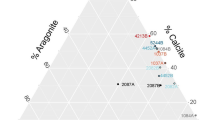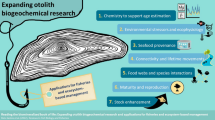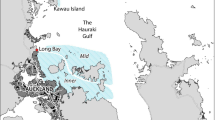Abstract
Otoliths, calcium carbonate (CaCO3) ear stones of fish, contain a wealth of information about fish life and environmental history yet the CaCO3 polymorph form the otolith is made of is a critical, but seldom considered, piece of information during otolith analysis. Otolith trace element chemistry data increasingly informs management decisions, but recent work has shown that CaCO3 polymorphs—aragonite, vaterite, and calcite—can bear on incorporation of trace elements in a non-trivial way. Most fishes are thought to have otoliths of the aragonite CaCO3 form, but this construct is potentially outdated with many recent literature reports showing otherwise. Our study used previously unpublished neutron diffraction data and reports from published literature to address three objectives: (1) summarize the relative effects of otolith CaCO3 polymorphism on otolith microchemistry, (2) summarize reports of otolith polymorphs to gain a better understanding of the extent of non-aragonite otoliths among fishes, (3) outline future research needed to align interpretations of microchemistry with our current understanding of otolith polymorph diversity. We found that while aragonite otoliths are the most common, so are exceptions. For example, the ostensibly rare (among species) CaCO3 form vaterite was reported in at least some otoliths of 40% of the species surveyed. Our work suggests that examination of the CaCO3 polymorph composition of otoliths should become more common particularly in studies where results will or may be used to inform management decisions. Future research should work to attribute controls on otolith CaCO3 polymorph expression using a combination of -omics and material characterization approaches to enrich the life history and environmental information output from otoliths and increase our understanding of the assumptions made in otolith trace element chemistry studies.




Similar content being viewed by others
References
Becker BJ, Fodrie FJ, McMillan PA, Levin LA (2005) Spatial and temporal variation in trace elemental fingerprints of mytilid mussel shells: a precursor to invertebrate larval tracking. Limnol Oceanogr 50:48–61
Benson DA, Karsch-Mizrachi I, Lipman DJ, Ostell J, Sayers EW (2009) GenBank. Nucleic Acids Res 37(Database issue):D26–D31 Epub 2008 Oct 21
Borelli G, Guibbolini ME, Mayer-Gostan N, Priouzeau F, De Pontual H, Allemand D, Puverel S, Tambutte E, Payan P (2003) Daily variations of endolymph composition: relationship with the otolith calcification process in trout. J Exp Biol 206:2685–2692
Bowen CA, Bronte CR, Argyle RL, Adams JV, Johnson JE (1999) Vateritic sagitta in wild and stocked lake trout: applicability to stock origin. Trans Am Fish Soc 128:929–938
Brandenberger E, Schintz HR (1945) Vtber die Natur der Verkalkungen bei Mensch und Tier und das Verhalten der anorganischen Knochensubstanz im Falle der haupt-sachlichen menschlichen Knochenkrankheiten. Helv Med Acta Suppl 16:1–63
Brophy D, Jeffries TE, Danilowicz BS (2004) Elevated manganese concentrations at the cores of clupeid otoliths: possible environmental, physiological, or structural origins. Mar Biol 144:779–786
Brown RJ, Severin KP (2009) Otolith chemistry analyses indicate that water Sr: Ca is the primary factor influencing otolith Sr: Ca for freshwater and diadromous fish but not for marine fish. Can J Fish Aquat Sci 66(10):1790–1808
Brown AD, Sisneros JA, Jurasin T, Nguyen C, Coffin AB (2013) Differences in lateral line morphology between hatchery-and wild-origin steelhead. PLoS ONE 8:e59162
Campana SE (1983) Feeding periodicity and the production of daily growth increments in otoliths of steelhead trout (Salmo gairdneri) and starry flounder (Platichthys stellatus). Can J Zool 61:1591–1597
Campana SE (1999) Chemistry and composition of fish otoliths: pathways, mechanisms and applications. Mar Ecol Prog Ser 188:263–297
Carlström D (1963) A crystallographic study of vertebrate otoliths. Biol Bull 125:441–463
Casselman JM (1990) Growth and relative size of calcified structures of fish. Trans Am Fish Soc 119:673–688
Chakoumakos BC, Pracheil BM, Koenigs RP, Bruch RM, Feygenson M (2016) Empirically testing vaterite structural models using neutron diffraction and thermal analysis. Sci Rep 6:36799
Chesney EJ, McKee BM, Blanchard T, Chan LH (1998) Chemistry of otoliths from juvenile menhaden Brevoortia patronus: evaluating strontium, strontium: calcium and strontium isotope ratios as environmental indicators. Mar Ecol Prog Ser 171:261–273
Ciccarelli FD, Doerks T, Von Mering C, Creevey CJ, Snel B, Bork P (2006) Toward automatic reconstruction of a highly resolved tree of life. Science 311:1283–1287
David AW, Grimes CB, Isely JJ (1994) Vaterite sagittal otoliths in hatchery-reared juvenile red drums. Prog Fish Cult 56:301–303
de Vries MC, Gillanders BM, Elsdon TS (2005) Facilitation of barium uptake into fish otoliths: influence of strontium concentration and salinity. Geochim Cosmochim Acta 69:4061–4072
Degens ET, Deuser WG, Haedrich RL (1969) Molecular structure and composition of fish otoliths. Mar Biol 2:105–113
Espino-Barr E, Gallardo-Cabello M, Cabral-Solís EG, Garcia-Boa A, Puente-Gómez M (2015) Analysis of the otoliths sagitta, asteriscus and lapillus of Yellowfin Mojarra Gerres cinereus (Perciformes: Gerreidae) in the coast of Colima and Jalisco, Mexico. Open J Ocean Coast Sci 2:18–33
Falini G, Fermani S, Vanzo S, Miletic M, Zaffino G (2005) Influence on the formation of aragonite or vaterite by otolith macromolecules. Eur J Inorg Chem 2005:162–167
Falini G, Fermani S, Reggi M, Džakula BN, Kralj D (2014) Evidence of structural variability among synthetic and biogenic vaterite. ChemComm 50:15370–15373
Federhen S (2011) The NCBI taxonomy database. Nucleic Acids Res 40:D136–D143
Gauldie RW (1986) Vaterite otoliths from chinook salmon (Oncorhynchus tshawytscha). New Zeal J Fresh 20:209–217
Gauldie RW (1990) Vaterite otoliths from the opah, Lampris immaculatus, and two species of sunfish, Mola mola and M. ramsayi. Acta Zool 71:193–199
Gauldie RW (1993) Polymorphic crystalline structure of fish otoliths. J Morphol 218:1–28
Gauldie RW (1996) Effects of temperature and vaterite replacement on the chemistry of metal ions in the otoliths of Oncorhynchus tshawytscha. Can J Fish Aquat Sci 53:2015–2026
Gauldie RW, Dunlop D, Tse J (1986) The remarkable lungfish otolith. New Zeal J Fresh 20:81–92
Gauldie RW, Sharma SK, Volk E (1997) Micro-Raman spectral study of vaterite and aragonite otoliths of the coho salmon, Oncorhynchus kisutch. Comp Biochem Physiol Part A Physiol 118:753–757
Halden NM, Friedrich LA (2008) Trace-element distributions in fish otoliths: natural markers of life histories, environmental conditions and exposure to tailings effluence. Mineral Mag 72:593–605
Hsu CC, Chang CW, Iizuka Y, Tzeng WN (2009) A growth check deposited at estuarine arrival in otoliths of juvenile flathead mullet (Mugil cephalus L.). Zool Stud 48:315–324
Immerman F (1908) Beitrage zur Altersbestimmung der Fische II Die innere Struktur der Schollenotolithen. Wiss Meeresuntersuch Abt Helgoland N F 8:129–176
Irie T (1955) The crystal texture of the otolith of a marine teleost. Pseudosciaena J Fac Fish Anim Husb Hiroshima Univ 1:1–8
Jessop BM, Shiao JC, Iizuka Y, Tzeng WN (2002) Migratory behaviour and habitat use by American eels Anguilla rostrata as revealed by otolith microchemistry. Mar Ecol Prog Ser 233:217–229
Johansson G (1966) Contribution to the biology of the dab (Limanda limanda L.) in Icelandic waters. Rit Fiskideildar 4:18–23
Larson AC, Von Dreele RB (2000) Report LAUR 86-748 Los Alamos National Laboratory, New Mexico, USA
Lenaz D, Miletic M, Pizzul E, Vanzo S, Adami G (2006) Mineralogy and geochemistry of otoliths in freshwater fish from Northern Italy. Eur J Mineral 18:143–148
Limburg KE, Elfman M (2017) Insights from two-dimensional map** of otolith chemistry. J Fish Biol 90:480–491
Limburg KE, Wuenschel MJ, Hüssy K, Heimbrand Y, Samson M (2018) Making the otolith magnesium chemical calendar-clock tick: plausible mechanism and empirical evidence. Rev Fish Sci Aquac 26:479–493
Loeppky AR, Chakoumakos BC, Pracheil BM, Anderson WG (2019) Otoliths of sub-adult Lake Sturgeon, Acipenser fulvescens, contain aragonite and vaterite calcium carbonate polymorphs. Fish Biol. https://doi.org/10.1111/jfb.13951
Long JM, Grabowski TB (2017) Otoliths. In: Quist MC, Isermann D (eds) Age and growth of fishes: principles and techniques. American Fisheries Society, Bethesda, pp 189–219
Macdonald JI, McNeil DG, Crook DA (2012) Asteriscus v. lapillus: comparing the chemistry of two otolith types and their ability to delineate riverine populations of common carp Cyprinus carpio. J Fish Biol 81:1715–1729
Maisey JG (1987) Notes on the structure and phylogeny of vertebrate otoliths. Copeia 1987:495–499
Melancon S, Fryer BJ, Ludsin SA, Gagnon JE, Yang Z (2005) Effects of crystal structure on the uptake of metals by lake trout (Salvelinus namaycush) otoliths. Can J Fish Aquat Sci 62:2609–2619
Melancon S, Fryer BJ, Markham JL (2009) Chemical analysis of endolymph and the growing otolith: fractionation of metals in freshwater fish species. Environ Toxicol Chem 28:1279–1287
Morales-Nin BYO (1987) The influence of environmental factors on microstructure of otoliths of three demersal fish species caught off Namibia. S Afr J Mar Sci 5(1):255–262
Morat F, Betoulle S, Robert M, Thailly AF, Biagianti-Risbourg S, Lecomte-Finiger R (2008) What can otolith examination tell us about the level of perturbations of Salmonid fish from the Kerguelen Islands? Ecol Freshw Fish 17:617–627
Morris RW, Kittleman LR (1967) Piezoelectric property of otoliths. Science 158:368–370
Morrongiello JR, Thresher RE, Smith DC (2012) Aquatic biochronologies and climate change. Nat Clim Change 2:849–857
Mugiya Y (1972) On aberrant sagittas of teleostan fishes. Jpn J Ichthyol 19:11–14
Murray CB (1994) A method for preparing Chinook salmon otoliths for age determination, and evidence of its validity. Trans Am Fish Soc 123:358–367
Nolf D (1985) In: Schultze HP (ed) Otolith piscium, vol 10. Handbook of paleoichthyology. G. Fischer Verlag, Deutsch, pp 1–145
Oliveira AM, Farina M, Ludka IP, Kachar B (1996) Vaterite, calcite, and aragonite in the otoliths of three species of piranha. Naturwissenschaften 83:133–135
Oxman DS, Barnett-Johnson R, Smith ME, Coffin A, Miller DL, Josephson R, Popper AN (2007) The effect of vaterite deposition on sound reception, otolith morphology, and inner ear sensory epithelia in hatchery-reared Chinook salmon (Oncorhynchus tshawytscha). Can J Fish Aquat Sci 64:1469–1478
Palmork KH, Taylor MEU, Coates R (1963) Crystal structure of aberrant otoliths. Acta Chem Scand 17:1457
Paquette J, Reeder RJ (1995) Relationship between surface structure, growth mechanism, and trace element incorporation in calcite. Geochim Cosmochim Acta 59:735–749
Parmentier E, Cloots R, Warin R, Henrist C (2007) Otolith crystals (in Carapidae): growth and habit. J Struct Biol 159:462–473
Pracheil BM, Hogan JD, Lyons J, McIntyre PB (2014) Using hard-part microchemistry to advance conservation and management of North American freshwater fishes. Fisheries 39:451–465
Pracheil BM, Chakoumakos BC, Feygenson M, Whitledge GW, Koenigs RP, Bruch RM (2017) Sturgeon and paddlefish (Acipenseridae) sagittal otoliths are composed of the calcium carbonate polymorphs vaterite and calcite. J Fish Biol 90(2):549–558
Pracheil BM, Lyons J, Hamann EJ, Short PH, McIntyre PB (2019) Lifelong population connectivity between large rivers and their tributaries: a case study of shovelnose sturgeon from the Mississippi and Wisconsin rivers. Ecol Freshw Fish 28(1):20–32
Reimer T, Dempster T, Warren-Myers F, Jensen AJ, Swearer SE (2016) High prevalence of vaterite in sagittal otoliths causes hearing impairment in farmed fish. Sci Rep 6:25249
Reimer T, Dempster T, Wargelius A, Fjelldal PG, Hansen T, Glover KA, Solberg MF, Swearer SE (2017) Rapid growth causes abnormal vaterite formation in farmed fish otoliths. J Exp Biol 220:2965–2969
Ren D, Feng Q, Bourrat X (2013) The co-effect of organic matrix from carp otolith and microenvironment on calcium carbonate mineralization. Mater Sci Eng C 33:3440–3449
Rietveld H (1969) A profile refinement method for nuclear and magnetic structures. J Appl Crystallogr 2:65–71
Sasaki H, Miyata J (1954) Experimental study on otoliths. Yonago Acta Med 1:49
Sayers EW, Barrett T, Benson DA, Bryant SH, Canese K, Chetvernin V, Church DM, DiCuccio M, Edgar R, Federhen S, Feolo M, Geer LY, Helmberg W, Kapustin Y, Landsman D, Lipman DJ, Madden TL, Maglott DR, Miller V, Mizrachi I, Ostell J, Pruitt KD, Schuler GD, Sequeira E, Sherry ST, Shumway M, Sirotkin K, Souvorov A, Starchenko G, Tatusova TA, Wagner L, Yaschenko E, Ye J (2009) Database resources of the National Center for Biotechnology Information. Nucleic Acids Res 37:D5–D15
Schultze HP (1988) Notes on the structure and phylogeny of vertebrate otoliths. Copeia 1988:257–259
Schulz-Mirbach T, Ladich F, Plath M, Heß M (2018) Enigmatic ear stones: what we know about the functional role and evolution of fish otoliths. Biol Rev 94(2):457–482
Secor DH, Dean JM, Laban EH (1992) Otolith removal and preparation for microstructural analysis. In: Stevenson DK, Campana SE (eds) Otolith micro-structure examination and analysis, vol 117. Canadian special publication of fisheries and aquatic sciences. Department of Fisheries and Oceans, Ottawa, pp 19–57
Söllner C, Burghammer M, Busch-Nentwich E, Berger J, Schwarz H, Riekel C, Nicolson T (2003) Control of crystal size and lattice formation by starmaker in otolith biomineralization. Science 302:282–286
Starrs D, Ebner BC, Fulton CJ (2016) All in the ears: unlocking the early life history biology and spatial ecology of fishes. Biol Rev 91:86–105
Strong MB, Neilson JD, Hunt JJ (1986) Aberrant crystallization of pollock (Pollachius virens) otoliths. Can J Fish Aquat Sci 43:1457–1463
Sweeting RM, Beamish RJ, Noakes DJ, Neville CM (2003) Replacement of wild coho salmon by hatchery-reared coho salmon in the Strait of Georgia over the past three decades. N Am J Fish Manag 23:492–502
Sweeting RM, Beamish RJ, Neville CM (2004) Crystalline otoliths in teleosts: comparisons between hatchery and wild coho salmon (Oncorhynchus kisutch) in the Strait of Georgia. Rev Fish Biol Fish 14:361–369
Tabouret H, Bareille G, Claverie F, Pécheyran C, Prouzet P, Donard OFX (2010) Simultaneous use of strontium: calcium and barium: calcium ratios in otoliths as markers of habitat: application to the European eel (Anguilla anguilla) in the Adour basin, South West France. Mar Environ Res 70:35–45
Thomas OR, Swearer SE, Kapp EA, Peng P, Tonkin-Hill GQ, Papenfuss A, Roberts A, Bernard P, Roberts BR (2019) The inner ear proteome of fish. FEBS J286:66–81
Toby BH (2001) EXPGUI, a graphical user interface for GSAS. J Appl Crystallogr 34:210–213
Tohse H, Saruwatari K, Kogure T, Nagasawa H, Takagi Y (2009) Control of polymorphism and morphology of calcium carbonate crystals by a matrix protein aggregate in fish otoliths. Cryst Growth Des 9:4897–4901
Tomás J, Geffen AJ (2003) Morphometry and composition of aragonite and vaterite otoliths of deformed laboratory reared juvenile herring from two populations. J Fish Biol 63:1383–1401
Tzeng WN, Chang CW, Wang CH, Shiao JC, Iizuka Y, Yang YJ, Ložys L (2007) Misidentification of the migratory history of anguillid eels by Sr/Ca ratios of vaterite otoliths. Mar Ecol Prog Ser 348:285–295
Veinott GI, Porter TR, Nasdala L (2009) Using Mg as a proxy for crystal structure and Sr as an indicator of marine growth in vaterite and aragonite otoliths of aquaculture rainbow trout. Trans Am Fish Soc 138:1157–1165
Wang J, Becker U (2009) Structure and carbonate orientation of vaterite (CaCO3). Am Mineral 94:380–386
Watson JE (1964) Determining the age of young herring from their otoliths. Trans Am Fish Soc 93:11–20
Wilson RR Jr (1985) Depth-related changes in sagitta morphology in six macrourid fishes of the Pacific and Atlantic Oceans. Copeia 1985:1011–1017
Acknowledgements
We thank Dan Daugherty for providing alligator gar otoliths, Allison Fortner for providing early manuscript comments, and Tony Lanzirotti and Matt Newville for providing beamline support for data generated at the Advanced Photon Source used in Fig. 3. This research used resources at the High Flux Isotope Reactor and Spallation Neutron Source, DOE Office of Science User Facilities operated by the Oak Ridge National Laboratory. Use of the Advanced Photon Source was supported by the U. S. Department of Energy, Office of Science, Office of Basic Energy Sciences, under Contract No. DE-AC02-06CH11357. Funding was provided by a Laboratory Directed Research and Development Seed Award.
Author information
Authors and Affiliations
Corresponding author
Additional information
Publisher's Note
Springer Nature remains neutral with regard to jurisdictional claims in published maps and institutional affiliations.
Copyright Notice
This manuscript has been authored by employees of UT-Battelle, LLC, under contract DE-AC05-00OR22725 with the U.S. Department of Energy. Accordingly, the United States Government retains and the publisher, by accepting the article for publication, acknowledges that the United States Government retains a non-exclusive, paid-up, irrevocable, world-wide license to publish or reproduce the published form of this manuscript, or allow others to do so, for United States Government purposes.
Electronic supplementary material
Below is the link to the electronic supplementary material.
Rights and permissions
About this article
Cite this article
Pracheil, B.M., George, R. & Chakoumakos, B.C. Significance of otolith calcium carbonate crystal structure diversity to microchemistry studies. Rev Fish Biol Fisheries 29, 569–588 (2019). https://doi.org/10.1007/s11160-019-09561-3
Received:
Accepted:
Published:
Issue Date:
DOI: https://doi.org/10.1007/s11160-019-09561-3




